Vannerie comme partie intégrante de l'habitat
>
Fetelevousmeme
>
Peer Map Culture : Approaches
>
Quelle philosophie ?
>
Based on Needs / Besoins Primaires
>
Abris / Shelter
Public Roads - The Greening of Public Roadsides , Nov/Dec 2007 - FHWA-HRT-08-001. By Amit Armstrong, Scott Riley, David Steinfeld, and Kim M.
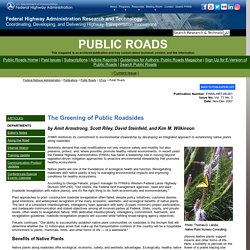
Wilkinson FHWA reinforces its commitment to environmental stewardship by developing an integrated approach to establishing native plants along roadsides. Motorists demand that road modifications not only improve safety and mobility but also preserve, protect, and, where possible, promote healthy natural environments. In recent years the Federal Highway Administration (FHWA) has taken a leadership role in moving beyond regulation-driven mitigation approaches to proactive environmental stewardship that promotes healthy ecosystems. Native plants are one of the foundations of ecological health and function. According to George Fekaris, project manager for FHWA's Western Federal Lands Highway Division (WFLHD), "Our clients, the Federal land management agencies, need and want [roadside revegetation with native plants], and it's the right thing to do, both economically and environmentally.
" Benefits of Native Plants According to Paul T.
8 Extraordinary Pieces of Architecture Grown From Living Trees. This living church is still growing.
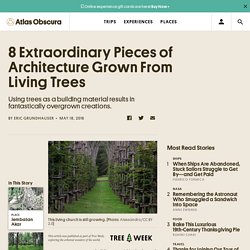
(Photo: Alessandro/CC BY 2.0) We usually use trees as building material in the form of struts and planks. But all over the world, people have found ways to create dwellings, bridges, and sculptures out of trees without even cutting them down. Using trees to create living structures is much slower to build (read: grow) than traditional methods, but it creates some truly fantastical natural creations.
Take a look at some of the world’s coolest feats of arbortecture. 1. Auerstedt, Germany (Photo: Pfauenauge/CC BY 2.0) This amazing sylvan dome, first planted in 1998, took 10 years to grow to completion.
Discount Raschel Mesh Tubing. Here’s a bit of good news from Patti Stouter.
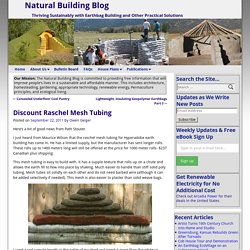
I just heard from Maurice Wilson that the raschel mesh tubing for Hyperadobe earth building has come in. He has a limited supply, but the manufacturer has sent longer rolls. These rolls up to 1400 meters long will still be offered at the price for 1000 meter rolls- $237 Canadian plus shipping. This mesh tubing is easy to build with. It has a supple texture that rolls up on a chute and allows the earth fill to flow into place by shaking. I used a red sample length in the gable of my shed and loved it more than the white or black bags or tubes above or below.
Contact Maurice at info@bagsupplies.ca at bagsupplies.ca to order.
Sans titre. Le matériel : Le matériel nécessaire à notre construction est basique : nous disposions d'une porte, d'une fenêtre, d'une cuve à eau, d'une brouette, plus une prêtée par un ami, et de petit matériel genre sécateur, pelle...
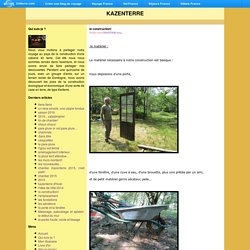
Nous avons fait appel à un tractopelle pour creuser un trou à la recherche d'argile. Nous avons acheté une bache de 6m sur 6 qui nous a servi à la fois pour le « patouillage » et pour recouvrir la kazenterre lors des fortes pluies de l'été. Et puis, comme nous n'avons pas pu finir le chantier dans le temps disponible, la bache recouvre notre Kazenterre pour l'aider à passer l'hiver ! Une Kerterre peut se faire avec de la végétation prise directement sur le terrain, la pro des Kerterres utilise maintenant du chanvre pour ses constructions (voir article dans « la maison écologique de août/sept 2014) encore faut il pouvoir en trouver facilement localement.
Pour notre part, nous avons utiliser de la paille, plus facile d'accès. Le matériel : nous disposions d'une porte,
Sans titre. A kishie is a traditional Shetland basket made from plant materials.
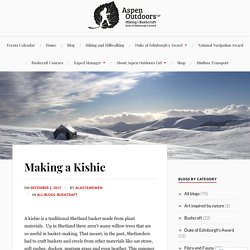
Up in Shetland there aren’t many willow trees that are so useful in basket-making. That meant, in the past, Shetlanders had to craft baskets and creels from other materials like oat straw, soft rushes, docken, marram grass and even heather. This summer I was in Shetland and learnt about how floss (soft rushes) were used to make simmens (rope) and how, with straw or dockens, kishies were made to carry things like peat and fish. My father’s side of the family are from Unst, the most northerly isle in Shetland.
Sans titre. A fun bushcraft project to try in the winter is to make a grass mat using a weaving loom made from hazel.
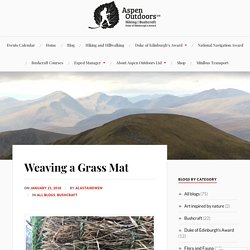
Here’s how you do it… The first step is to make the loom. Look for a hazel tree and collect several long straight branches of dead standing wood about a thumb thickness in diameter. Cut these branches up so that you have the following: 4 hazel sticks about 50cm long (sharpen one end of each stick so you can stick them in the ground) 2 hazel sticks about 50cm long with a Y shaped end (sharpen the ends of these as well); and Three lengths of hazel about 1m long (two to from the ends of the loom and one bit to batten the grass) Next collect some soft rushes, let them dry for a week or more, then weave them into rope (see the Making a Kishie blog for more information on how to do this). Now make the loom. Next stick the 4 other 50cm bits of hazel into the ground about 2m away, evenly spaced out about 15cm apart. Next collect lots and lots of dry grass. Next get scissors and trim the edges.






